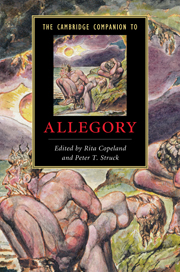Book contents
- Frontmatter
- Introduction
- Part I: Ancient foundations
- Part II: Philosophy, theology, and poetry 200 to 1200
- 4 Allegory and ascent in Neoplatonism
- 5 Allegory in Christian late antiquity
- 6 Allegory in Islamic literatures
- 7 Twelfth-century allegory: philosophy and imagination
- Part III: Literary allegory: philosophy and figuration
- Part IV: The fall and rise of allegory
- Further reading
- Index
5 - Allegory in Christian late antiquity
from Part II: - Philosophy, theology, and poetry 200 to 1200
Published online by Cambridge University Press: 28 January 2011
- Frontmatter
- Introduction
- Part I: Ancient foundations
- Part II: Philosophy, theology, and poetry 200 to 1200
- 4 Allegory and ascent in Neoplatonism
- 5 Allegory in Christian late antiquity
- 6 Allegory in Islamic literatures
- 7 Twelfth-century allegory: philosophy and imagination
- Part III: Literary allegory: philosophy and figuration
- Part IV: The fall and rise of allegory
- Further reading
- Index
Summary
Writing sometime around 1330 in the general prologue to his first literal commentary on the Bible, the Franciscan biblical scholar, Nicholas of Lyra, summarizes what he understands to be the patristic and medieval consensus concerning the interpretation of Scripture. Any scriptural text may, he says, contain four senses, the “literal” (also “historical” or “narrative”), the “moral” (sometimes called “tropological”), the allegorical and the “anagogical” (aka “mystical”). “And these four senses,” he adds, “may be explained by way of illustration by the word “Jerusalem”. In its literal sense it refers to a certain city which was once the capital of the kingdom of Judea, founded in the first instance by Melchisedech and later expanded and fortified by Solomon. But in its moral sense it refers to the faithful soul; it is in this sense that Isaiah says: Rise up, Jerusalem, take your seat (52:2). But in its allegorical sense it refers to the Church militant, as when it says in Revelation 21:2: I saw the holy city, the new Jerusalem, coming down from heaven, like a bride dressed for her husband. In its anagogical sense it refers to the Church triumphant, as Galatians 4:26 says: She who is above is Jerusalem the freed-woman and she is our mother. We have given as an example a single word; in the same way a single passage could be given, and as in the one case so in others.” / At least verbally, Nicholas is right: his account of the “four senses of Scripture” thus schematically set out would have been acceptable at any point in the western Christian tradition in the period from late antiquity to his own day in the fourteenth century.
- Type
- Chapter
- Information
- The Cambridge Companion to Allegory , pp. 71 - 82Publisher: Cambridge University PressPrint publication year: 2010
- 2
- Cited by



